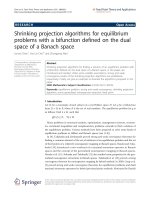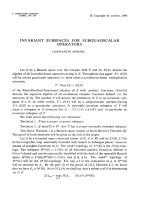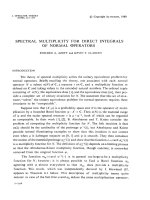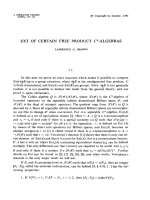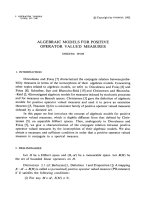Báo cáo toán học: "Automated Proofs for Some Stirling Number Identities" pptx
Bạn đang xem bản rút gọn của tài liệu. Xem và tải ngay bản đầy đủ của tài liệu tại đây (95.25 KB, 7 trang )
Automated Proofs for Some Stirling Number Identities
Manuel Kauers
∗
and Carsten Schneider
†
Research Institute for Symbolic Computation
Johannes Kepler University
Altenbergerstraße 69
A4040 Linz, Austria
Submitted: Sep 1, 2007; Accepted: Dec 4, 2007; Published: Jan 1, 2008
Mathematics Subject Classification: 68W30
Abstract
We present computer-generated proofs for some summation identities for (q-)Stir-
ling and (q-)Eulerian numbers that were obtained by combining a recent summation
algorithm for Stirling number identities with a recurrence solver for difference fields.
1 Introduction
In a recent article [5], summation algorithms for a new class of sequences defined by certain
types of triangular recurrence equations are given. With these algorithms it is possible to
compute recurrences in n and m for sums of the form
F (m, n) =
n
k=0
h(m, n, k)S(n, k)
where h(m, n, k) is a hypergeometric term and S(n, k) are, e.g., Stirling numbers or Eule-
rian numbers. Recall that these may be defined via
S
1
(n, k) = S
1
(n − 1, k − 1) − (n − 1)S
1
(n − 1, k) S
1
(0, k) = δ
0,k
, (1)
S
2
(n, k) = S
2
(n − 1, k − 1) + kS
2
(n − 1, k) S
2
(0, k) = δ
0,k
, (2)
E
1
(n, k) = (n − k)E
1
(n − 1, k − 1) + (k + 1)E
1
(n − 1, k) E
1
(0, k) = δ
0,k
. (3)
∗
; Partially supported by FWF grants SFB F1305 and P16613-N12
†
; Partially supported by FWF grants SFB F1305.
Part of this work was done while the two authors were attending the Trimestre on methods of proof theory
in mathematics at the Max-Planck-Institute for Mathematics, Bonn, Germany.
the electronic journal of combinatorics 15 (2008), #R2 1
The original algorithms exploit hypergeometric creative telescoping [9]. More generally,
the algorithms can be extended to work for any sequence h(m, n, k) that can be rephrased
in a difference field in which one can solve creative telescoping problems. Since such
problems can be solved in Karr’s ΠΣ-fields [3, 8], we can allow for h(m, n, k) any indefinitely
nested sum or product expression, such as (q-)hypergeometric terms, harmonic numbers
H
k
=
k
i=1
1
i
, etc. Moreover, S(n, k) may satisfy any triangular recurrence of the form
S(n, k) = a
1
(n, k)S(n + α, k + β) + a
2
(n, k)S(n + γ, k + δ) (4)
with α, β, γ, δ ∈ Z and
α
β
γ
δ
= ±1 and coefficients a
1
(n, k) and a
2
(n, k) that can be defined
by any indefinite nested sum or product over k. In connection with creative telescoping in
ΠΣ-fields, the algorithms of [5] directly extend to this more general class of summands.
Given a summand f(m, n, k) = h(m, n, k)S(n, k) as specified above and given a finite
set of pairs S ⊆ Z
2
, the algorithms construct, if possible, expressions c
i,j
(m, n), free of k,
and g(m, n, k) such that the creative telescoping equation
(i,j)∈S
c
i,j
(m, n)f(m + i, n + j, k) = g(m, n, k + 1) − g(m, n, k) (5)
holds and can be independently verified by simple arithmetic.
Summing (5) over the summation range leads to a recurrence relation, not necessarily
homogeneous, of the form
(i,j)∈S
c
i,j
(m, n)F (m + i, n + j) = d(m, n). (6)
The validity of this recurrence follows, similar to the hypergeometric setting [6], from (5),
but is typically not obvious if (5) is not available. Therefore, g(m, n, k) (the only informa-
tion contained in (5) but not in (6)) is called the certificate of the recurrence.
In the following section, we give a detailed example for proving a Stirling number
identity involving harmonic numbers in this way. A collection of further identities about
q-Stirling numbers that can be proven analogously is given afterwards.
2 A Detailed Example
Consider the sum
F (m, n) =
m
k=1
H
m−k
(m − k)!(−1)
m−k+1
m
k − 1
=:h(m,n,k)
S
1
(k − 1, n)
=:S(n,k)
=:f(m,n,k)
.
Here, S
1
refers to the (signed) Stirling numbers of the first kind.
the electronic journal of combinatorics 15 (2008), #R2 2
The algorithm of [5] reduces the recurrence construction to some creative telescoping
problems which can be solved by algorithms for ΠΣ fields [7]. The solutions to all these
equations are combined to the recurrence equation
F (m, n) − 2mF (m, n + 1) − 2F (m + 1, n + 1)
+ m
2
F (m, n + 2) + (2m + 1)F (m + 1, n + 2) + F(m + 2, n + 2)
= S
1
(m − 1, n + 1) − (m − 1)S
1
(m − 1, n + 2),
which the algorithm returns as output along with the certificate
g(m, n, k) =
(k−1)
(k−m−3)(k−m−2)
(−1)
m−k
(m − k)!
m
k − 1
×
(k
2
− 3mk − 6k + 2m
2
+ 6m + 6 + (k − 2)(k − m − 1)H
m−k
)S
1
(k − 1, n + 2)
+ (k − m − 3)((k − m − 1)H
m−k
− 1)S
1
(k − 1, n + 1)
.
The certificate g(m, n, k) allows us to verify the recurrence for F (m, n) independently.
Indeed, using the triangular recurrence (1) for S
1
and the obvious relations for factorials,
harmonic numbers, etc. it is readily checked that
f(m, n, k) − 2mf(m, n + 1, k) − 2f(m + 1, n + 1, k)
+ m
2
f(m, n + 2, k) + (2m + 1)f(m + 1, n + 2, k) + f(m + 2, n + 2, k)
= g(m, n, k + 1) − g(m, n, k).
Now sum this equation for k = 1, . . . , m − 1. This gives
m−1
k=1
f(m, n, k) − 2m
m−1
k=1
f(m, n + 1, k) − 2
m−1
k=1
f(m + 1, n + 1, k)
+ m
2
m−1
k=1
f(m, n + 2, k) + (2m + 1)
m−1
k=1
f(m + 1, n + 2, k) +
m−1
k=1
f(m + 2, n + 2, k)
=
m−1
k=1
g(m, n, k + 1) − g(m, n, k)
.
The right hand side collapses to g(m, n, m) − g(m, n, 1). On the left hand side, we can
express the sums in terms of the F (m + i, n + j) using, e.g.,
m−1
k=1
f(m + 1, n + 2, k) = F (m + 1, n + 2) − f(m + 1, n + 2, m) − f(m + 1, n + 2, m + 2).
Bringing finally everything but the F (m + i, n + j) to the right hand side and doing some
straightforward simplifications gives the recurrence claimed by the algorithm.
the electronic journal of combinatorics 15 (2008), #R2 3
With the recurrence for F (m, n) at hand, it is an easy matter to prove the closed form
representation
F (m, n) =
1
2
(n + 1)(n + 2)S
1
(m, n + 2).
Just check that the closed form satisfies the same recurrence (this is easy) and a suitable
set of initial values.
The creative telescoping problems arising during the execution of the algorithm are
interesting also from a computational point of view. One of these equations, as an example,
is
(k−1)(k−m−1)((k−m)H
m−k
+1)
k(k−m)
2
H
m−k
b
2
(m, n, k + 1) − b
2
(m, n, k)
− c
2,0
(m, n) +
(m+1)((m−k+1)H
m−k
+1)
(m−k+2)H
m−k
c
2,1
(m, n)
−
(m+1)(m+2)((m−k+1)H
m−k
+1)((m−k+2)H
m+1−k
+1)
(m−k+2)(m−k+3)H
m−k
H
m+1−k
c
2,2
(m, n) = 0,
where b
2
(m, n, k) and the c
i
(n, m) are to be determined. This equation differs from most
equations arising from natural (non-Stirling-) sums in that harmonic number expressions
also arise in denominators.
3 Some q-Identities
Subsequently, we consider some q-versions of the well-known identities
n
k=m
n
k
S
2
(k, m) = S
2
(n + 1, m + 1), (7)
n
k=m
(−1)
n−k
k
m
S
1
(n, k) = (−1)
n−m
S
1
(n + 1, m + 1). (8)
Following Gould [2], we define the q-Stirling numbers via
S
(q)
1
(n, k) = q
1−n
S
(q)
1
(n − 1, k − 1) − [n − 1]S
(q)
1
(n − 1, k), S
(q)
1
(0, k) = δ
0,k
,
S
(q)
2
(n, k) = q
k−1
S
(q)
2
(n − 1, k − 1) + [k]S
(q)
2
(n − 1, k), S
(q)
2
(0, k) = δ
0,k
,
where [n] = (q
n
− 1)/(q − 1) and δ refers to the Kronecker delta. By
n
k
q
we denote the
q-binomial coefficient, defined as
n
k
q
= [n]!/[k]!/[n − k]!.
1. We prove the identity [4, Id. 1]
n
k=m
q
k
n
k
S
(q)
2
(k, m) = S
(q)
2
(n + 1, m + 1)
by computing the recurrence
q(1 − q)F(m + 1, n + 1) − (1 − q)q
m+2
F (m, n) − q(1 − q
m+2
)F (m + 1, n) = 0
the electronic journal of combinatorics 15 (2008), #R2 4
for the sum F (m, n) =
n
k=m
q
k
n
k
S
(q)
2
(k, m) with the proof certificate
g(m, n, k) = −
k(q − 1)q
k+1
k − n − 1
n
k
S
(q)
2
(k, m + 1).
2. The identity [4, Id. 2]
n
k=m
(−1)
n−k
k
m
S
(q)
1
(n, k)q
−k
= (−1)
n−m
S
(q)
1
(n + 1, m + 1)
follows from the recurrence
−(q − 1)q
n+1
F (m + 1, n + 1) + (q − 1)F (m, n) + (q
n+1
− 1)F (m + 1, n) = 0
with the proof certificate
g(m, n, k) =
(−1)
n−k
(m − k)(q − 1)q
1−k
m + 1
k
m
S
(q)
1
(n, k − 1).
3. For the sum
F (m, n) =
n
k=m
(−1)
n−k
k
m
q
S
1
(n, k)q
−k
,
involving a q-binomial, we compute the recurrence relation
F (m, n) + q(q
m
+ n)F (m + 1, n) − qF (m + 1, n + 1) = 0
with the proof certificate
g(m, n, k) = −
(−1)
n−k
q(q
k
− q
m
)
q
m+k
(q
m+1
− 1)
k
m
q
S
1
(n, k − 1).
This yields another q-version of identity (8). Namely, define
˜
S
(q)
1
(n, k) by
˜
S
(q)
1
(n + 1, k + 1) = q
−1
˜
S
(q)
1
(n, k) − (q
k
+ n)
˜
S
(q)
1
(n, k + 1)
and
˜
S
(q)
1
(0, k) = δ
0,k
. Observe that in the limit q → 1 this also specializes to S
1
(n, k). Then
by construction we get the q-version
n
k=m
(−1)
n−k
k
m
q
S
1
(n, k)q
−k
= (−1)
n−m
˜
S
(q)
1
(n + 1, m + 1).
4. For
F (m, n) =
n
k=m
(−1)
n−k
k
m
q
S
(q)
1
(n, k)q
−k
the electronic journal of combinatorics 15 (2008), #R2 5
we compute the recurrence
−(q − 1)q
n+1
F (m + 1, n + 1) + q(−q
m
+ q
m+1
+ q
n
− 1)F (m + 1, n) + (q − 1)F (m, n) = 0
with the proof certificate
g(m, n, k) = −
(−1)
n−k
(q − 1)q(q
k
− q
m
)
q
m+k
(q
m+1
− 1)
k
m
q
S
(q)
1
(n, k − 1).
If we define
¯
S
(q)
1
(m, n) by
¯
S
(q)
1
(n + 1, k + 1) =
1
(1 − q)q
n
(−q
k
+ q
k+1
+ q
n
− 1)
¯
S
(q)
1
(n + 1, k) + q
−n−1
¯
S
(q)
1
(n, k)
and
¯
S
(q)
1
(0, k) = δ
0,k
, which specializes in the limit q → 1 to S
1
(n, k), we arrive at the
q-version
n
k=m
(−1)
n−k
k
m
q
S
1
(n, k)q
−k
= (−1)
n−m
¯
S
(q)
1
(n + 1, m + 1).
5. Carlitz [1] defines the q-Eulerian numbers E
(q)
1
(n, m) by requesting that they satisfy
[m]
n
=
n+1
k=1
E
(q)
1
(n, k)
m + k − 1
n
q
,
which is a q-analogue of the Worpintzky identity [1]. He derives the recurrence equation
E
(q)
1
(n + 1, k) = [n + 2 − k]E
(q)
1
(n, k − 1) + q
n+1−k
[k]E
(q)
1
(n, k).
Conversely, taking this recurrence equation and suitable initial conditions as the definition
of the q-Eulerian numbers, we find that the sum
F (n, m) =
n+1
k=1
E
(q)
1
(n, k)
m + k − 1
n
q
satisfies the recurrence
(q
m
− 1)F (n, m) − (q − 1)F (n + 1, m) = 0,
the certificate being
g(m, n, k) = −
q
−k−1
(q
k+m
− q)(q
k
− q
n+2
)
q
n+1
− 1
k + m − 2
n
q
E
(q)
1
(n, k − 1).
The identity F (m, n) = [m]
n
follows easily.
the electronic journal of combinatorics 15 (2008), #R2 6
Remark. A closed form representation cannot be found for every sum, but almost
always it is possible to construct a recurrence equation. For instance, for
F (m, n) =
n
k=m
k(−1)
n−k
k
m
q
S
1
(n, k)q
−k
we compute the recurrence relation
− q
2
(q
m+1
+ n)
2
F (m + 2, n) + q
2
(2q
m+1
+ 2n + 1)F(m + 2, n + 1)
− q
2
F (m + 2, n + 2) − q(q
m
+ q
m+1
+ 2n)F (m + 1, n) + 2qF (m + 1, n + 1) − F (m, n) = 0
with the proof certificate
g(m, n, k) =
(−1)
n−k
q
−k−2m+1
(q
k
−q
m
)
[
k
m
]
q
((k−1)(q
k+1
−1)S
1
(n,k−1)q
m
+k(q
k
−q
m+1
)S
1
(n,k−2))
−q
m+1
−q
m+2
+q
2m+3
+1
.
References
[1] L. Carlitz. q-Bernoulli and Eulerian numbers. Transactions of the AMS, 76(2):332–350,
1954.
[2] H. W. Gould. The q-Stirling numbers of first and second kind. Duke Journal of
Mathematics, 28(2):281–289, 1961.
[3] M. Karr. Summation in finite terms. J. ACM, 28:305–350, 1981.
[4] J. Katriel. Stirling number identities: interconsisteny of q–analogues. J. Phys. A: Math.
Gen., 31:3559–3572, 1998.
[5] M. Kauers. Summation Algorithms for Stirling Number Identities. Journal of Symbolic
Computation, 42(11):948–970, 2007.
[6] M. Petkovˇsek, H. Wilf, and D. Zeilberger. A = B. AK Peters, Ltd., 1997.
[7] C. Schneider. Solving parameterized linear difference equations in terms of indefinite
nested sums and products. J. Differ. Equations Appl., 11(9):799–821, 2005.
[8] C. Schneider. Symbolic summation assists combinatorics. S´em. Lothar. Combin., 56:1–
36, 2007. Article B56b.
[9] D. Zeilberger. The method of creative telescoping. J. Symbolic Comput., 11:195–204,
1991.
the electronic journal of combinatorics 15 (2008), #R2 7

